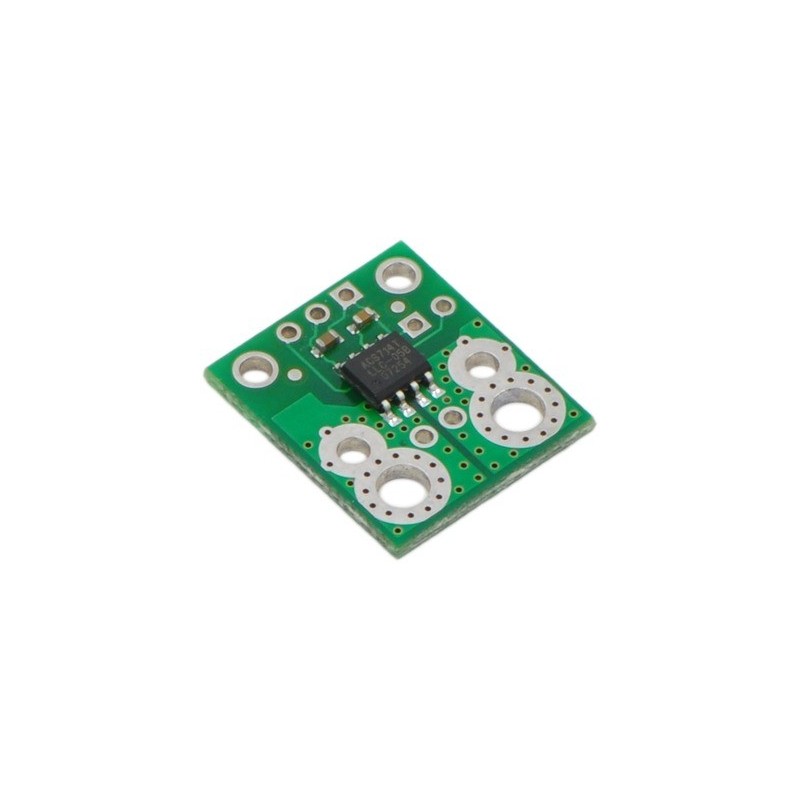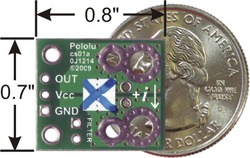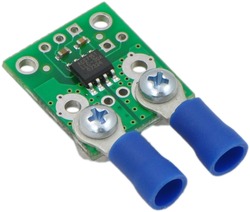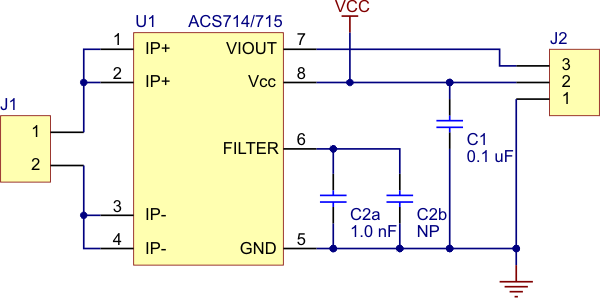

ACS714 Current Sensor Carrier -5 to +5A
This board is a simple carrier of Allegro’s ±5A ACS714 Hall effect-based linear current sensor, which offers a low-resistance (~1.2 m?) current path and electrical isolation up to 2.1 kV RMS. This version accepts a bidirectional current input with a magnitude up to 5 A and outputs a proportional analog voltage (185 mV/A) centered at 2.5 V with a typical error of ±1.5%. It operates from 4.5 to 5.5 V and is intended for use in 5 V systems.
 |
This current sensor is a carrier board or breakout board for Allegro’s ACS714LLCTR-05B-T Hall effect-based linear current sensor; we therefore recommend careful reading of the ACS714 datasheet (661k pdf) before using this product. The sensor operates at 5 V and has an output sensitivity of 185 mV/A. The board ships fully populated with its SMD components, including the ACS714, as shown in the product picture. The following list details some of the sensor’s key features:
The pads are labeled on the bottom silkscreen, as shown in the picture to the right. The silkscreen also shows the direction that is interpreted as positive current flow via the +i arrow.
Like almost all our carrier boards, this sensor ships assembled with all of its required surface mount components, as shown in the main product picture.
We sell a 30A unidirectional version and ±30A bidirectional version version of this board; you can distinguish these versions by reading the text on the IC or by looking at the color of the X on the bottom silkscreen. This version is marked with a blue X.
 |
| ACS715 current sensor carrier with solderless ring terminal connectors (not included). |
|---|
The sensor requires a supply voltage of 4.5 – 5.5 V to be connected across the Vcc and GND pads, which are labeled on the bottom silkscreen. The sensor outputs an analog voltage that is linearly proportional to the input current. When Vcc is 5 V, this output voltage is centered at 2.5 V and changes by 185 mV per amp of input current, with positive current increasing the output voltage and negative current decreasing the output voltage.
The input current can be connected to the board in a variety of ways. For low-current applications, you can solder 0.1" male header pins to the board via the small through-holes on the input-current side of the board. For higher-current applications, you can solder wires directly to the through-holes whose sizes best match your wires, or you can use solderless ring terminal connectors, as shown in the picture to the right. The large through-holes are big enough for #6 screws.
The board has two mounting holes on the logic side of the board. These mounting holes are 0.5" apart and are designed for #2 screws.
The IC has an internal filter resistance of 1.7 kΩ, and the carrier board includes a 1 nF filter capacitor, which produces a low-pass RC filter with a 90 kHz cutoff. You can improve sensing system accuracy for low-frequency sensing applictations by adding a capacitor in parallel with the integrated 1 nF capacitor across the pads marked “filter” on the bottom silkscreen (this capacitor is labeled C2b in the schematic below). The frequency F that the filter will attenuate to half its original power is given by:
F = 1 / (2đRC) = 1 / (11kΩ * (1 nF + Cf))
where Cf is the value of the capacitor added to the filter pads.
 |
| Pololu ACS714/ACS715 current sensor carrier schematic diagram. |
|---|
 |
ACS714 Current Sensor Carrier -30 to +30A |
 |
ACS715 Current Sensor Carrier 0 to 30A |
 |
0.1" (2.54mm) Crimp Connector Housing: 1x3-Pin 25-Pack |
Producent BTC Korporacja sp. z o. o. Lwowska 5 05-120 Legionowo Polska sprzedaz@kamami.pl 22 767 36 20
Osoba odpowiedzialna BTC Korporacja sp. z o. o. Lwowska 5 05-120 Legionowo Polska sprzedaz@kamami.pl 22 767 36 20
Kompaktowy czujnik prądu oparty na technologii Halla, umożliwiający dokładny pomiar prądu DC i AC w zakresie ±10 A z galwaniczną izolacją. Ma analogowe wyjście VOUT z dużą czułością i pasmem 150 kHz, co pozwala na szybkie i precyzyjne odczyty w dynamicznych układach. Moduł pracuje w szerokim zakresie temperatur od -40°C do 125°C, a niska rezystancja ścieżki prądowej minimalizuje straty energii. Dzięki niewielkim wymiarom i elastycznym opcjom montażu jest idealny do zastosowań w prototypach, systemach przemysłowych i projektach o ograniczonej przestrzeni. Pololu 5454
Moduł z czujnikiem prądu INA169. Układ może być zasilany napięciem od 2,7 V do 60 V i ma wyjście analogowe. SparkFun SEN-12040
Crowtail – Electricity Sensor 2.0 umożliwia precyzyjny pomiar prądu przemiennego do 5 A, przekształcając sygnał na napięcie analogowe 2 V. Przeznaczony do projektów monitoringu energii i integracji z systemami mikrokontrolerów.
Kompaktowy czujnik prądu oparty na technologii Halla, umożliwiający dokładny pomiar prądu DC i AC w zakresie ±30 A z galwaniczną izolacją. Ma analogowe wyjście VOUT z dużą czułością i pasmem 150 kHz, co pozwala na szybkie i precyzyjne odczyty w dynamicznych układach. Moduł pracuje w szerokim zakresie temperatur od -40°C do 125°C, a niska rezystancja ścieżki prądowej (~1,6 mΩ) minimalizuje straty energii. Dzięki niewielkim wymiarom i elastycznym opcjom montażu jest idealny do zastosowań w prototypach, systemach przemysłowych i projektach o ograniczonej przestrzeni. Pololu 5451
Brak towaru
Czujnik pozwala mierzyć natężenie prądu płynącego w przewodzie bez jego rozcinania. Pomiar odbywa się w sposób indukcyjny na pojedynczym przewodzie. Wyjściem sensora jest napięcie analogowe w zakresie od 0 do 1 V. SCT-013-005
Brak towaru
Moduł czujnika prądu ACS72981, który wykorzystuje efekt Halla do precyzyjnego i bezpiecznego pomiaru prądu AC oraz DC, zapewniając elektryczną izolację ścieżki prądowej. Dzięki szerokopasmowemu wyjściu analogowemu (do 250 kHz) i niskiej rezystancji przewodzącej (0,2 mΩ) minimalizuje straty energii i oferuje szybki czas reakcji poniżej 2 µs. Pololu 5256
Moduł czujnika natężania prądu wykonujący pomiary w zakresie -40 ~ 40 A, z niską rezystancją 0,7 mΩ i izolacją elektryczną do 3 kV. Pololu 4033
Precyzyjny czujnik prądu oparty na efekcie Halla, oferujący izolację galwaniczną, szerokie pasmo przenoszenia 150 kHz oraz możliwość pomiaru prądu AC i DC z bardzo niskimi stratami mocy. Dzięki różnicowemu pomiarowi i odporności na zakłócenia magnetyczne, doskonale sprawdza się w aplikacjach wymagających dokładnego monitorowania prądu, takich jak zasilacze, przetwornice czy systemy sterowania silnikami. Pololu 5293
Moduł precyzyjnego cyfrowego czujnika prądu umożliwiający pomiar napięcia, prądu i mocy modułów elektronicznych i urządzeń w zakresie do 26V i 8A z błędem względnym do ±0,2%. DFRobot SEN0291
Kompaktowy czujnik prądu oparty na technologii Halla, umożliwiający dokładny pomiar prądu DC i AC w zakresie ±10 A z galwaniczną izolacją. Ma analogowe wyjście VOUT z dużą czułością i pasmem 150 kHz, co pozwala na szybkie i precyzyjne odczyty w dynamicznych układach. Moduł pracuje w szerokim zakresie temperatur od -40°C do 125°C, a niska rezystancja ścieżki prądowej minimalizuje straty energii. Dzięki niewielkim wymiarom i elastycznym opcjom montażu jest idealny do zastosowań w prototypach, systemach przemysłowych i projektach o ograniczonej przestrzeni. Pololu 5444
Moduł czujnika prądu ACS71240, który wykorzystuje efekt Halla do precyzyjnego i bezpiecznego pomiaru prądu AC oraz DC, zapewniając elektryczną izolację ścieżki prądowej. Dzięki szerokopasmowemu wyjściu analogowemu (do 120 kHz) i niskiej rezystancji przewodzącej (0,6 mΩ) minimalizuje straty energii i oferuje szybki czas reakcji poniżej 5 µs. Pololu 5245
Moduł czujnika prądu ACS71240, który wykorzystuje efekt Halla do precyzyjnego i bezpiecznego pomiaru prądu AC oraz DC, zapewniając elektryczną izolację ścieżki prądowej. Dzięki szerokopasmowemu wyjściu analogowemu (do 120 kHz) i niskiej rezystancji przewodzącej (0,6 mΩ) minimalizuje straty energii i oferuje szybki czas reakcji poniżej 5 µs. Pololu 5246
Moduł z czujnikiem prądu i napięcia dedykowany do płytek Feather. Może mierzyć napięcie do 26 V i prąd do 3,2 A. Oparty na czujniku INA219, komunikacja I2C. Adafruit 3650
Precyzyjny czujnik prądu oparty na efekcie Halla, oferujący izolację galwaniczną, szerokie pasmo przenoszenia 150 kHz oraz możliwość pomiaru prądu AC i DC z bardzo niskimi stratami mocy. Dzięki różnicowemu pomiarowi i odporności na zakłócenia magnetyczne, doskonale sprawdza się w aplikacjach wymagających dokładnego monitorowania prądu, takich jak zasilacze, przetwornice czy systemy sterowania silnikami. Pololu 5290
Moduł z czujnikiem prądu ACS724LLCTR-05AU o zakresie pomiarowym prądu od 0 do 5 A. Komunikuje się przez interfejs analogowy. Pololu 4048
Moduł z czujnikiem INA228 przeznaczony do monitorowania mocy. Pozwala na pomiar napięć do 85 VDC oraz prądu do 10 A. Wykorzystuje 20-bitowy przetwornik ADC, dzięki czemu gwarantuje bardzo precyzyjne i dokładne pomiary dostępne przez magistralę I2C. Adafruit 58332

ACS714 Current Sensor Carrier -5 to +5A
